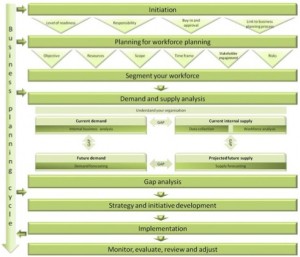Certify and Increase Opportunity.
Be
Govt. Certified HR Staffing Manager
General Description
Workforce management (WFM) encompasses all the activities needed to maintain a productive workforce. Under the umbrella of human resource management, WFM is sometimes referred to as HRMS systems, or even part of ERP systems. Recently, the concept of workforce management has begun to evolve into workforce optimization.
Below is a list of key concepts used in the Flow process:
1. Work group: A functional section or division of an enterprise responsible for a ring-fenced discipline. A small enterprise might have a single work group, while large enterprise might have many work groups.
2. Data Destination: The definition of a database or file location used by the enterprise. It is used as input to the flow process, and also the destination for the delivery of results from
the flow process.
3. Measurement Definition: Sometimes referred to as a “Import Definition”; a query on a data destination that provides rows for new job cards. It is a measurement definition because it
measures shortcomings in the enterprise that requires an action to be taken.
4. Task Name: The header for a job card template. Every job type has its own job card
template. The template consists of a number of fixed field names, common to all job types, and a number of user defined fields for the specific job type.
5. Premise: The data fields of jobs include a field for the measurement definition, and a field for Premise. The premise is a unique number or code for an address. The system allows only
one active job per measurement definition per premise.
6. Page rule: The execution of a job is guided by page rules. The user defined fields of job cards are organised on pages. The execution of the job jumps between page numbers depending on the values entered according to page rules for the job type.4
7. Business rule: A set of rules defining the follow-up actions on completed jobs, depending on the data collected during the execution of the job.
8. Export rule: A definition on how the data of the enterprise must be updated on job
completion.
9. External Function: A definition to retrieve, update or insert data on or from an enterprise data destination. External functions take parameters from job card fields, and are used in
export rules, letter templates, email templates and SMS templates.
10. Personnel Responsibilities: A matrix defining who is responsible for each job type in each geographical zone.
11. Activity: An activity is the main building block of a project. Activities have prerequisites of other activities, and can consist of one or many jobs.
12. Project: A set of activities to achieve a specific goal. A project has a planned start date and a planned completion date
Apply for HR Staffing Certification Now!!
http://www.vskills.in/certification/Certified-HR-staffing-manager


